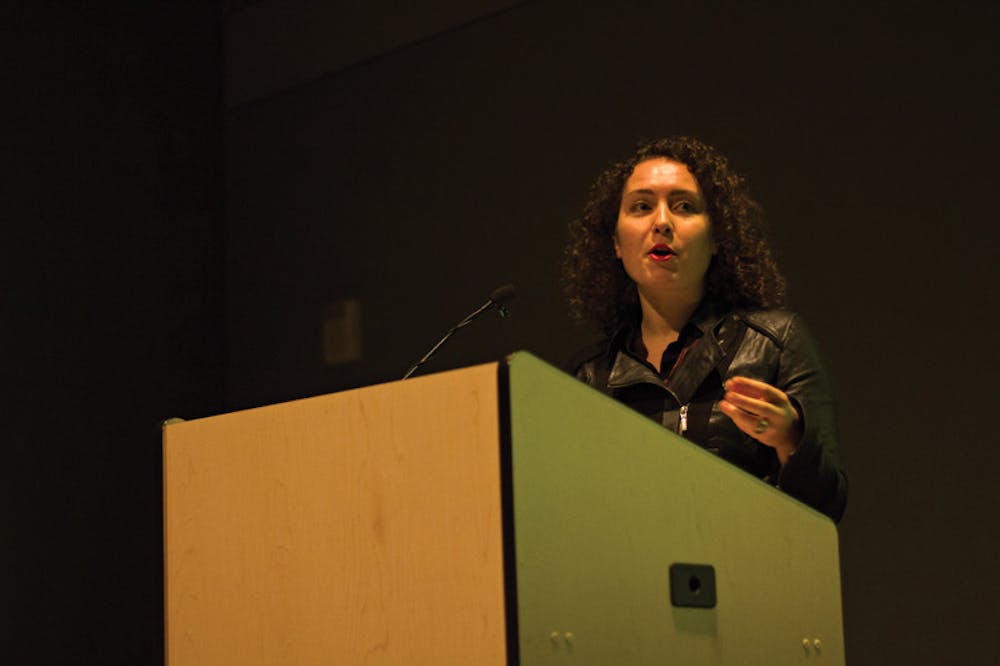In a snapshot of a page from a writer’s notebook, strips of text overlapped at perpendicular angles like woven ribbons. The notebook belongs to Lecturer in English Michael Stewart, one of three speakers at the Creative Mind lecture this past Wednesday. The lecture, which took place in the Englander Studio of the Perry and Marty Granoff Center for the Creative Arts, was the first Creative Mind lecture of the 2013-2014 academic year.
The series aims to promote and explore creativity across multiple fields of study. In addition to Stewart, speakers included curator Julian Jimarez Howard ’11 and blogger Maria Popova.
Aside from his award-winning publications in fiction and poetry, Stewart, who spoke first, more recently authored “The Answers,” a website of responses to anonymously submitted questions. Stewart’s poetic but often tangentially related answers aim not to serve a practical purpose, but an artistic one.
Stewart’s vision of creativity is “curiosity applied,” he told The Herald. While questions are necessary, they may not probe for answers so much as serve to explore and observe a medium, he added.
“The subject (of exploration) is inert, but the speaker is alive,” he told The Herald. “If artists can dive in and dive deeply into that, everything else will follow.”
Emblematic of his medium of writing, his notebook is a place to sprinkle “seeds,” he said. “It (creates) a place to pause and be present, think ‘this thing is important but I have no idea why.’ It’s a place for it (to) sit, aware, the whole time.”
Despite this emphasis on active immersion in the creative process, Stewart also acknowledged the importance of occasionally detaching focus from the task at hand.
“Let go of what you can’t grasp — the tighter you hold on, the less likely you are to get anything out of it,” he said, adding that the “mingling perspectives” of conversation can be a stimulating muse.
Jimarez Howard, the next speaker, is a curator and writer. One of his most recent projects was co-founding OUTLET Fine Arts, a commercial art space in Brooklyn aiming to “(promote) creativity through exhibitions, collaborations and out-of-the-box explorations,” according to the company website.
In his lecture, Jimarez Howard defined curating as an “idiosyncratic methodology to create a system of relationships,” adding that the etymological root of the word “curate” — to care for — is a crucial bedrock to his ideology.
He said that while some say applying a relationship of “symbol and emotion” to a collection of objects involves too much attachment to the material, this systematic construction of meaning is an integral aspect of the human experience.
Stewart’s notebook, an image on one of Jimarez Howard’s slides, revealed “(his), but also everyone’s creative process — organizing things into certain patterns and certain ways of beings,” Jimarez Howard said. “Everyone does this one way or another,” he added, whether through the arrangements of books on a bookshelf or the opened tabs in an internet browser.
He closed his lecture with a slide of gold prospectors in California, explaining that humans similarly “(mine) for nuggets” in an age of “increasingly inundating” information, thus curating reality by applying “our own method of creating worth and value.”
Popova, the final speaker, is the impetus behind Brain Pickings, a critically acclaimed blog, which is described on its information page as a “human-powered discovery engine for interestingness.” In her posts, Popova explores eclectic avenues she finds to be of cultural and intellectual merit — including literature, history, art, science and philosophy. Popova said the multidisciplinary scope of her work is driven by her notion of “combinatorial creativity,” which is the synthesis of pre-existing concepts into an “original” idea.
“This is more than a theoretical, conceptual thing — it lives in everything we touch,” she said. Everything builds upon what came before it, she said, citing inventions such as the radio and the Gutenberg printing press as created through the mixing of existing ideas.
Popova, herself borrowing from theories put forth by the social psychologist Graham Wallas, said the most important element of the creative process is “incubation” — otherwise known as “unconscious cerebration” by Alexander Graham Bell and “mental mastication” by Lewis Carroll.
Incubation is the brain’s stewing of information — “where the alchemy takes place,” Popova said, “but we don’t allow our minds to be still long enough for this to happen.”
She added that society’s goal-oriented outlook toward creativity has resulted in a “cult of productivity over presence,” citing an overemphasis on “how to optimize (creativity), maximize it … force it into a blueprint.”
Students had positive reactions to the lectures.
“I feel like the creative process is so varied between different people that one of the biggest challenges is to find your own,” Deivid Ribeiro ’13.5 said. “The speakers did a great job of showing how this process can be brought out through other people’s ideas and applied to create something new.”
Alex Herbert-Rapport ’15 said he was especially inspired by the notion of “interrupting your schedule to enable yourself to new concepts.”
“Breaking from your work to reflect during the creative process can be applied not only to writing books and blogs, but to everything,” he said.
Kamille Johnson ’16 echoed this sentiment.
“What was most interesting is that they brought the field of creativity into a tangible realm,” she said. “They showed that productivity isn’t the only goal —value comes from a longer, more cumulative process that can’t be finished in a day’s work.”

ADVERTISEMENT




